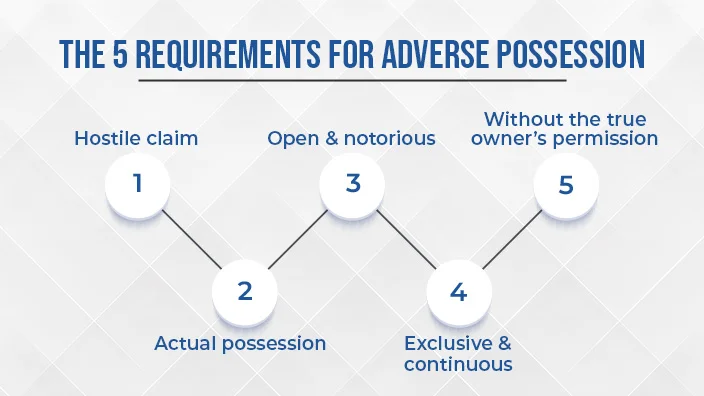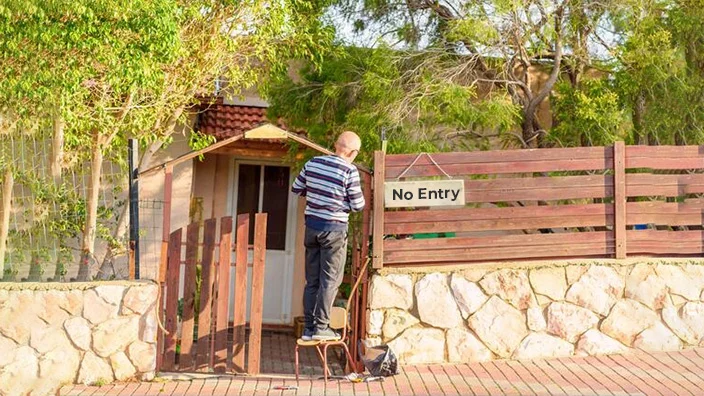Adverse possession, which is often referred to as squatter’s rights, is a legal principle that includes certain requirements that allow an individual to claim possession of a property if they’ve been in occupation of it for a sufficient period of time without getting the rightful owner’s permission.
Though laws can vary significantly by jurisdiction, there are generally 5 key requirements that must be met for a person seeking adverse possession successfully.
In this article, we’ll explain what’s adverse possession, the difference between adverse possession and homesteading, and detail what are the 5 requirements for adverse possession claims.
Table of Contents
What is Adverse Possession?
The term “adverse possession” basically refers to a legal principle that gives title to someone residing on or being in possession of someone else’s land or property.
The property’s title is granted to the trespasser or possessor as long as they meet certain conditions, which include being in continuous possession of the property, and whether they trespass the rights of the rightful owner.
Understanding property rights or property law and adverse possession is important for property owners to prevent adverse possession claims and guard their property ownership.
Adverse possession is sometimes referred to as squatter’s rights, though squatter’s rights aren’t a recorded law but a colloquial reference to the idea.
Adverse possession laws permit trespassers to enter someone else’s property, occupy it for a certain period of time, and gain ownership. A person claiming adverse possession makes him/her legally liable for the property.
The Core of Adverse Possession
As outlined above, adverse possession is a legal situation in which one person is granted valid title to another person’s land or property by taking possession.
This can either happen intentionally or unintentionally with or without the knowledge of the property owner.
 In case of an intentional claim of adverse possession, a squatter or trespasser knowingly claims ownership of another person’s land or property and/or takes over it. In other cases, adverse possession may happen to be unintentional as well.
In case of an intentional claim of adverse possession, a squatter or trespasser knowingly claims ownership of another person’s land or property and/or takes over it. In other cases, adverse possession may happen to be unintentional as well.
For example, a homeowner builds a fence separating their yard from their neighbor’s without realizing they’ve intruded on their neighbor’s property line.
In either case, the adverse possessors or the trespasser can lay claim to that property. If the claimant succeeds in proving adverse possession, they don’t need to pay the owner for the property.
Related Article: How To Get Eviction Off Your Record
Adverse Possession vs Homesteading
Adverse possession is just the same as homesteading in practice. In homesteading, a government owned land without any clear owner is granted to new owners as long as they’re using and improving it.
If a homesteaderisn’t utilizing the property, they can lose it. Adverse possession can work in the same way by freeing up land with an unclear and undecided title for productive use. Of course, adverse possession can be abused in a manner homesteading can’t be.
If there exists an informal easement between two farms where one of the farmer’s fences holds an acre of the neighbor’s land in it, for instance, the farmer using the property can claim adverse possession to bite off that portion of land if there’s no drafted easement agreement.
Adverse Possession Requirements
The requirements for proving adverse possession tend to vary among jurisdictions. In many states, a deed of paying property taxes on a land or paying taxes is essentially needed for a claimant to be successful.
Each state has a given time limit during which the landowner of record can nullify the claim at any time. An incorrect deed is not considered.
 For example, if the state threshold is twenty years and the landowner pays for any maintenance on the house in question in even the 19th year, it’ll give the claimant a tough time proving adverse possession.
For example, if the state threshold is twenty years and the landowner pays for any maintenance on the house in question in even the 19th year, it’ll give the claimant a tough time proving adverse possession.
That said, the landowner is advised to get rid of the adverse possession as soon as possible by signing agreements for any use of a land owned or property owned.
To claim land under adverse possession successfully, it must be demonstrated by the claimant that their occupation of the land meets the requirements given below: -
Hostile claim
Let’s get started with the first requirement, which is the claimant’s possession of the property in question must be hostile.
Hostile doesn’t mean, in this context, that the claimant should be in animosity or a contentious relationship with the landowner. Rather, it denotes the nature of the possession itself.
In this legal context, hostile means that the claimant’s use of the property is in direct conflict with the actual owner’s rights.
Essentially, the property is used by the claimant as if they were the deserving owner, without any legal right or permission to do so.
It demonstrates an obvious and deliberate infringement on the true owner’s rights, which is an important element in claiming any adverse possession.
This could manifest in different ways, like erecting structures, making improvements on the land, or doing activities typical of a real owner. These actions show a clear intention to own and control the land, which is mandatory for a hostile claim.
Actual Possession
Actual possession, the second requirement, simply means that the claiming the property must be typically occupying the property.
While this may seem quite straightforward, possession can manifest in many forms beyond just occupying or living on the property.
 For example, it could include using the property for farming, rubbing a business, or storing personal belongings. The key thing here is that the claimant treats the property as their own, and their using it is clear to anyone who looks.
For example, it could include using the property for farming, rubbing a business, or storing personal belongings. The key thing here is that the claimant treats the property as their own, and their using it is clear to anyone who looks.
It’s not sufficient to merely assert a claim to the property, the claimant must show an actual, tangible use of it.
Additionally, the claimant must be consistently using the property over time. Occasional or intermittent use won’t fulfill the requirement for actual possession.
Open and Notorious
The third requirement for having an adverse possession claim of property is that it should be open and notorious, which means the claimant’s use of the land isn’t secretive or hidden but apparent and visible.
The claimant’s possession of the land should be apparent to the true owner, neighbors, or anyone passing by.
As per principle, the true owner of the property must be having a reasonable opportunity to become aware of the adverse possession and take the plunge to reclaim their property.
If the adverse possession is secretive or hidden, then the true owner wouldn’t have this opportunity.
Therefore, the claimant’s use of the property must be dealt with in such a way that it would be clear to the reasonable owner which could involve planting crops, building structures, or using it in any other form that makes the possession obvious.
Exclusive and Continuous
The fourth requirement is that the claimant must be using the land exclusively and continuously for the statutory time. In terms of exclusivity, the land must be possessed only by the claimant.
 They can’t share the possession with someone else, though they can grant permission as an owner would. To meet this requirement, the claimant must be acting as a true owner, not merely a co-user or tenant.
They can’t share the possession with someone else, though they can grant permission as an owner would. To meet this requirement, the claimant must be acting as a true owner, not merely a co-user or tenant.
As far as continuity and uninterrupted possession are concerned, the claimant’s possession of the land must be uninterrupted for the whole statutory period. This specified period varies by jurisdiction but is generally from 5 to 20 years.
It doesn’t mean also that the claimant must be physically present there on the land every single day or physically occupy it. However, their use of the property must be manner consistent in the way a true owner would use it.
The final requirement for adverse possession is the claimant’s possession of the property must be without the true owner’s possession.
If the owner has permitted the claimant to use the property, then adverse possession can’t be claimed by the claimant.
 This is because the claimant’s use of the property is no longer ‘hostile’ as outlined above.
This is because the claimant’s use of the property is no longer ‘hostile’ as outlined above.
Essentially, if the owner has permitted the claimant to use the land, then the claimant’s possession of the property isn’t infringing on the true owner’s rights.
As in this case, the owner leases the land to the claimant or otherwise grants them permission to use it. So, the claimant isn’t in adverse possession; they’re merely exercising the rights that the true owner grants them.
How to Prevent Adverse Possession?
Being a landowner, you can take certain steps to prevent a trespasser from taking property ownership, which are as follows: -
- Identify and mark your land or property boundaries.
- Keep inspectingyour land regularly for signs of trespassers.
- Offer to rent the land or property to the trespasser by having a rental agreement in place. This will prevent the trespasser from claiming adverse possession of the property.
- Grant written permissions to the person using your land, also making sure you secure their written acknowledgment.
- Act fast to prevent the trespasser from being on your property for the detailed statutory period. This will make your case successful.
Conclusion
Summing up the discussion, what are the 5 requirements for adverse possession? Meeting adverse possession requirements is essential to successfully claim the ownership of a property.
Meeting these requirements includes: -
- The claimant must have a hostile claim to the property,
- They must be typically occupying the property,
- Their claim to property must be notorious and open to the true owner or any other person,
- the claimant must be using the land exclusively and continuously for the statutory period,
- The claimant’s possession of the property must be without the true owner’s possession.
Additionally, being a landowner, you can take certain steps to prevent a trespasser from taking property ownership by identifying and marking your property boundaries, and offering to rent the property to the trespasser.
Frequently Asked Questions
What are the 5 main elements to obtain an adverse possession of a property?
All the elements of adverse possession include the claimant’s having a hostile, notorious, and open claim to the property, and its exclusive use and continuous use for the statutory period.
Granting written permission to the person using your property, and acting fast to prevent the trespasser from being on your property are good options to avoid adverse possession.
What is the hostile element of adverse possession?
Hostile refers to the claimant’s use of the property as if they were the deserving owner, without any legal right or permission to do so.
What is true of adverse possession?
Adverse possession refers to a legal principle that gives title to someone residing on or owning someone else’s land or property, if they’ve used it continuously, openly, notoriously, and occupied exclusively.


















